Yesterday I posted below analysis in the comment and chatter thread because I wasn’t sure the length of it made it worth posting in this thread, but since first reactions were positive, here we go.
In the following I try to analyze some trends in volume growth during winter months. I worked from the following assumptions:
1. In 1979, at the start of the satellite era, the arctic was just getting out of a more or less stable situation regarding sea ice volume since it took some time until global warming was really making impact. By 1990 changes were well underway, so instead of taking 1979 as a starting point, I use PIOMAS volume data between 1990-2019. I think this is justifiable also because in climatology a three decade period is used as baseline.
Graphs depicting monthly volumes over these years show a pretty constant decline. See for example this graphs of april volume over the years (any other month would do as well, although october and november show a bit more variance in recent years):
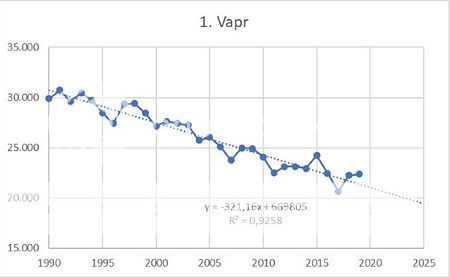
2. Since september ASI extent is getting lower over the years, there is more and more open water to refreeze. So you would expect ASI volume growth (Vgrowth) between october and april next spring to increase. And also that this above average Vgrowth occurs mainly in autumn. Once the arctic sea is frozen over and ice has somewhat thickened, Vgrowth will probably resume more normal growth rates. Lately it has been taking us more or less to the end of the year until all high arctic seas are frozen over again.
This is indeed what you see when you compare the linear trendline in the graph depicting Vgrowth in the october-april period for example with Vgrowth between februari and april.

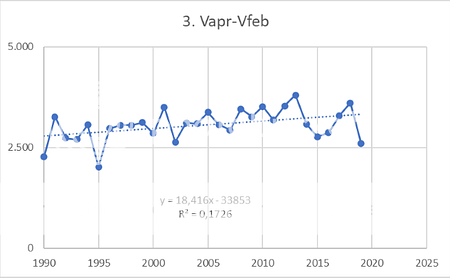
The linear trendline of Vgrowth in the october-april period has the biggest gradient and this gradient gets a bit smaller every month after that. If you put these gradients of the trendlines of Vgrowth from a specific month till the end of the freezing seasons (april) in a separate graph, it makes a good fit and corroborates nicely what is to be expected. Graph 4 is again for the 1990-2019 period.

3. Now for the main course and why this analysis may be relevant for this freezing season and ones to come. Many here on the ASIF regard 2007 as the year in which arctic sea ice extent and volume crashed in such a way that it brought about profound changes in sea ice state and dynamics. If this is correct and a threshhold was passed, then it makes sense to have a look at Vgrowth before and after 2007 separately.
Graph 2 above depicting Vgrowth between october-april indeed suggests something happened in 2007. As an extraordinary meltseason resulted in untill then unknown amounts of open water in september, Vgrowth in the following freezing season 2007-2008 was - rather unsurprisingly - at an all time high. The same can be said about the freezing season following the 2012 melt out. But interestingly, although there have been quite a few big melting seasons in the last decade, this effect of extra Vgrowth caused by huge swaths of open water in september, seems to be waning over the years. At least it looks like that when when you break up the 1990-2019 period in the time frames 1990-2007 and 2008-2019, see graph 5.
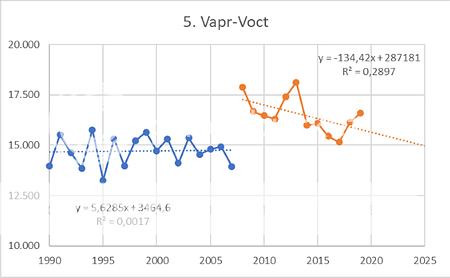
Admittedly, the 2008-2019 time period is short and the variance here is rather large. But lets first have a look at some other months-april freezing periods. This decline in extra Vgrowth over the 2008-2019 time frame clearly is most pronounced in autumn.
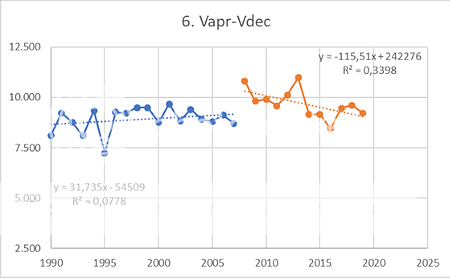
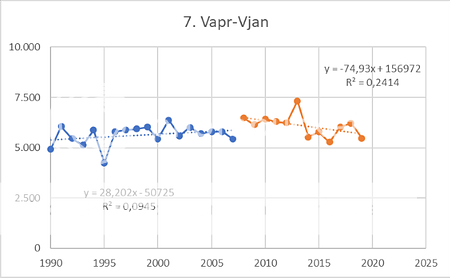
This is what you get when you plot the gradients of trendlines for volume growth in the different months-april periods:
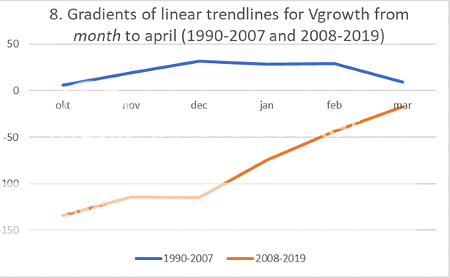
There was a slightly positive trend in Vgrowth for any month-april period in the 1990-2007 time frame, but this is definitely not the case for the years 2008-2019. And especially not for the october-april, nov-apr and dec-apr freezing periods. This suggests that the extra refreeze in autumn is more and more being hampered by other influences such as extra heat uptake in summer, atlantification and higher air temperatures. Since trendlines of Vgrowth over the jan-apr and feb-apr periods are negative also, it seems that these influences extend into the deep of winter.
Of course the outcome of this analysis is strongly influenced by taking 2007 as a kind of tipping point. Maybe this is not justified. And maybe the period 2008-2019 is too short for trustworthy trendlines. But all-in-all the results are remarkably consistent. So maybe we should expect much lower Vgrowth and thus Vmax in years to come.
Save another shift in dynamics like in 2007, which could worsen things considerably and is possibly happening as we speak, the 2008-2019 trendline for Vgrowth from oct-apr will be back at 15k km3 in 2025 (graph 5), just as it was in the years 1990-2007. Add these 15k to the max. 5k probably remaining at the end of october 2025 and you get 20k km3 in april (the simple Vapr lineair trendline in graph 1 predicts 19,5k for april 2025). Since summer melt is around 18 ± 1,5K since 2007, it looks like fascinating and frightening times are at our doorstep.
It wil be interesting to see what the monthly volumes will be this freezing season, but it is difficult to imagine they will not contribute strongly to these downward trends in Vgrowth.
